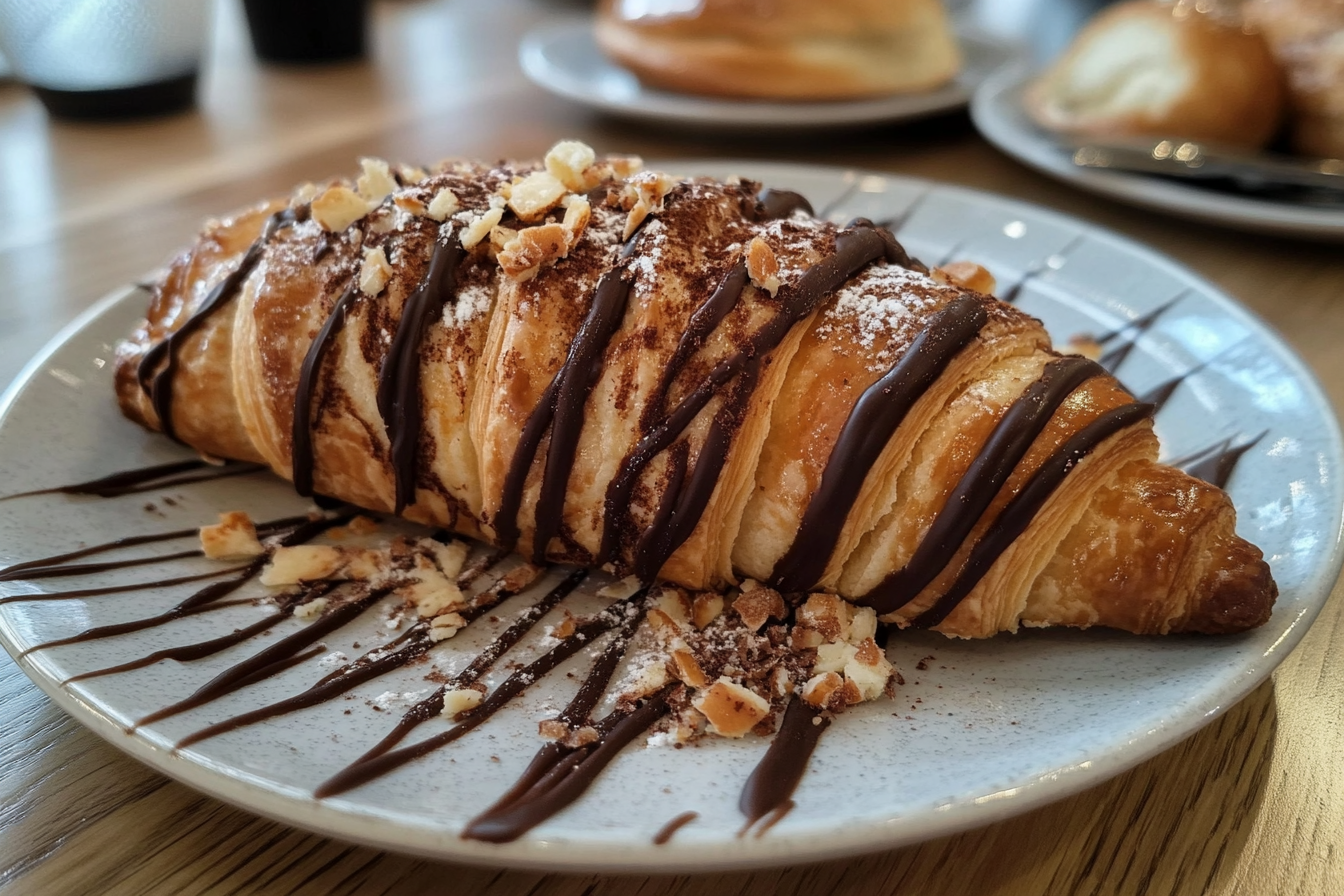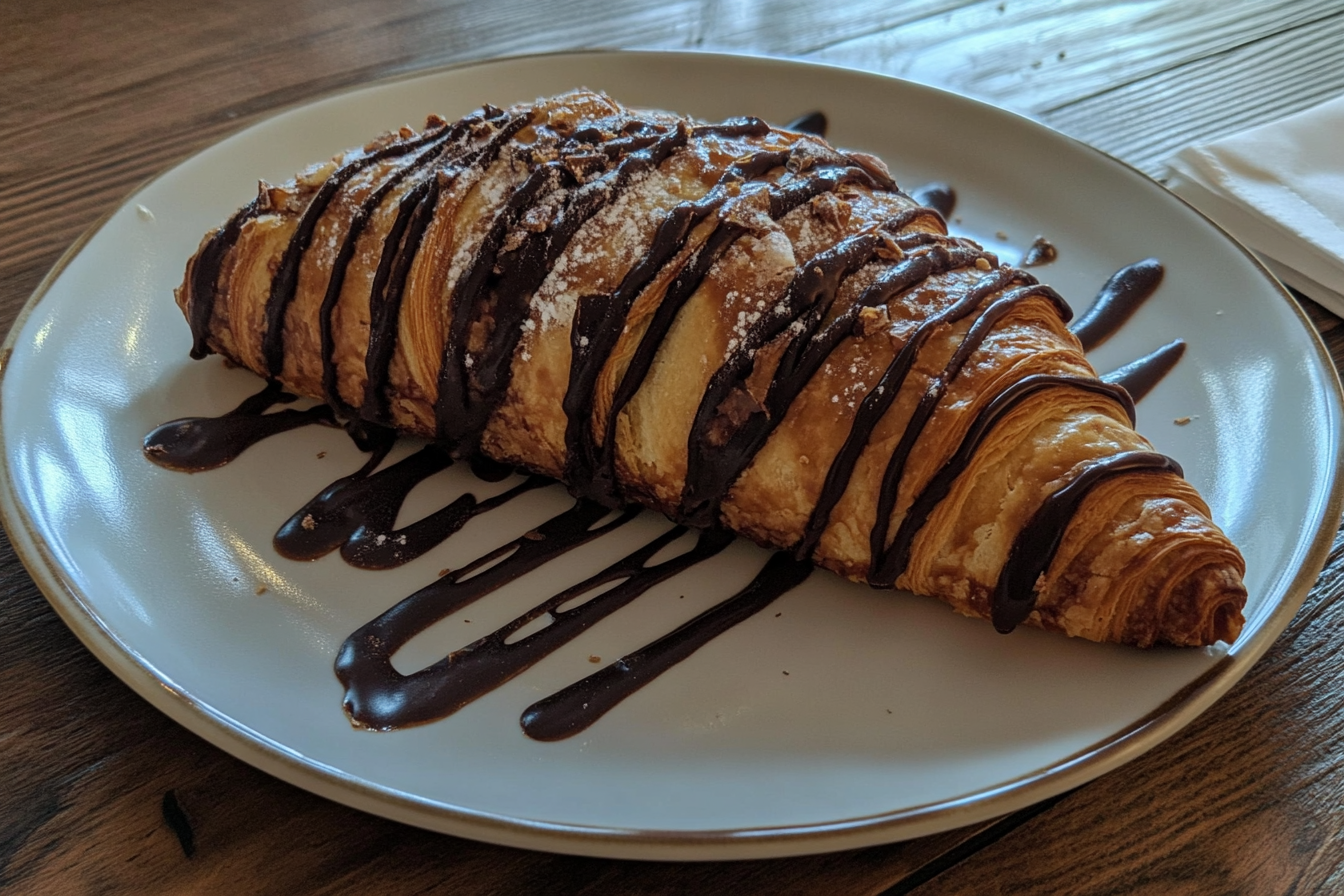Chocolate croissants, also called pain au chocolat, are among the most beloved pastries globally. Combining buttery, flaky dough with rich chocolate, these treats offer an indulgent flavor experience. This article delves into the history of chocolate croissants, examines the types of chocolate typically used, and provides tips for those interested in making them at home.
Origins of the Chocolate Croissant
The story of the croissant begins not in France, as many might think, but in Austria. Originally known as kipferl, these crescent-shaped pastries became popular in Austria during the 13th century. French bakers transformed the kipferl into what we now recognize as the croissant by incorporating layers of butter into the dough. A chocolate croissant is a close relative of the classic croissant but with an added twist: rich, melted chocolate nestled inside the layers.
The Arrival of Pain au Chocolat
Incorporating chocolate into croissants came later. Pain au chocolat, as we know it today, was popularized in France in the 19th century. French bakers used high-quality dark chocolate to create a unique pastry with layers of buttery dough and a gooey, chocolate-filled center. Traditionally enjoyed as a breakfast item, pain au chocolat has become a popular choice for dessert or snack any time of day.
For those interested in exploring French pastry culture further, Eira Recipes’ chocolate croissant guide provides a deeper dive into the evolution of these treats and offers valuable tips for preparing them at home.
What Makes a Chocolate Croissant Special?
The chocolate croissant stands apart due to its unique composition. Made with laminated dough, the croissant undergoes a folding process that creates distinct layers. These layers contribute to the pastry’s light, flaky texture, which complements the rich chocolate filling. When baked, the dough puffs up, creating a golden-brown exterior and an airy interior that envelops the melted chocolate.
Ingredients Used in a Classic Chocolate Croissant
A traditional chocolate croissant typically includes the following ingredients:
- Butter: Essential for the lamination process, butter gives the pastry its distinct flavor and texture.
- Flour: High-quality flour is essential for achieving the right dough consistency.
- Yeast: The dough rises and develops a light, airy texture through the yeast.
- Sugar and Salt: These enhance flavor, balancing the buttery taste.
- Chocolate: Dark chocolate is the classic choice, though variations exist.
Each ingredient plays a role in achieving the perfect chocolate croissant, from the flavor profile to the texture. Using quality ingredients helps to elevate the taste, ensuring a delicious experience.
Pain au Chocolat vs. Chocolate Croissant
The terms pain au chocolat and chocolate croissant are often used interchangeably, but they represent slightly different pastries. Pain au chocolat refers specifically to a rectangular pastry with chocolate bars rolled into the dough, while a chocolate croissant may come in various shapes and sometimes includes sweeter or creamier chocolate fillings. However, the two share a focus on rich, buttery pastry and melted chocolate filling, creating a delightful treat with every bite.
Types of Chocolate Commonly Used
The chocolate in a chocolate croissant isn’t just a filling; it’s a defining feature that influences the flavor, texture, and even the experience of enjoying this pastry. Choosing the right type of chocolate is essential for creating the ideal flavor profile, and different types offer unique characteristics.
1. Dark Chocolate: The Traditional Choice
Dark chocolate is the most common type used in chocolate croissants, known for its deep, rich flavor and balanced sweetness. Typically, dark chocolate with a cocoa content of 60-70% is preferred, as it pairs well with the buttery pastry without being too sweet. Dark chocolate holds its shape well, providing a satisfying bite that complements the croissant’s flaky layers.
Benefits of Dark Chocolate in Croissants:
- Balanced Flavor: Dark chocolate provides a slight bitterness that balances the buttery pastry.
- Texture Stability: It melts slowly, preventing it from becoming overly runny.
- Healthier Option: With antioxidants and lower sugar content, dark chocolate can be a healthier choice.
2. Semi-Sweet Chocolate: A Balanced Flavor
Semi-sweet chocolate offers a middle ground, combining the richness of dark chocolate with a hint of sweetness. Often used by bakers looking for a lighter flavor profile, semi-sweet chocolate is an excellent option for those who prefer a less intense taste.
Characteristics:
- Slightly Sweet: Adds a touch of sweetness without overpowering the buttery pastry.
- Smooth Melt: Semi-sweet chocolate melts evenly, creating a gooey texture inside the croissant.
3. Milk Chocolate: The Sweeter Alternative
While less traditional, some bakers use milk chocolate in chocolate croissants to achieve a sweeter, creamier taste. Milk chocolate has a higher sugar content and a creamier texture, offering a different experience than dark or semi-sweet chocolate.
Pros and Cons of Milk Chocolate in Croissants:
- Sweeter Flavor: Milk chocolate adds sweetness, making it popular among those who prefer dessert-like pastries.
- Creamy Texture: This chocolate type creates a soft, creamy filling that melts readily.
- Less Bitter: The absence of bitterness makes milk chocolate suitable for those who enjoy a lighter chocolate taste.
For bakers exploring different chocolate options, Eira Recipes’ article on chocolate varieties provides guidance on selecting the right chocolate type for various baked goods.
Why Dark Chocolate is Preferred by Many Bakers
Dark chocolate remains the favorite choice for traditional chocolate croissants due to its high cocoa content and robust flavor profile. The bitterness in dark chocolate complements the croissant’s buttery layers, resulting in a balanced taste. Additionally, dark chocolate’s stability in baking ensures it melts smoothly without becoming too runny.
How Dark Chocolate Elevates the Pastry
Dark chocolate provides more than just flavor. Its texture and melt characteristics enhance the croissant experience in several ways:
- Satisfying Bite: The structure of dark chocolate ensures it holds its shape while still melting slightly, providing a rich mouthfeel.
- Balance of Flavors: The slightly bitter undertone of dark chocolate contrasts beautifully with the buttery pastry, preventing the croissant from tasting too sweet.
- Enhanced Richness: Dark chocolate’s cocoa content delivers a depth of flavor that complements the croissant’s layers.
The result is a pastry that feels luxurious and indulgent without being overly sweet, making dark chocolate the preferred choice for many bakers.
Importance of Chocolate Quality
When making chocolate croissants, the quality of the chocolate directly impacts the final result. High-quality chocolate melts more evenly, has a smooth texture, and offers a rich, nuanced flavor. In contrast, cheaper chocolate can become grainy or overly sweet, detracting from the croissant’s taste.
Characteristics of High-Quality Chocolate:
- Smooth Texture: Premium chocolate melts evenly, creating a satisfying mouthfeel.
- Rich Flavor: Quality chocolate offers complex flavors, enhancing the croissant.
- Consistent Results: High-quality brands provide reliability, making it easier to achieve the same delicious results every time.
Many professional bakers recommend using brands like Valrhona, Callebaut, and Guittard for baking, as they provide a smooth melt and a balanced flavor profile.
How Chocolate Affects the Texture and Taste of a Croissant
Chocolate influences a croissant’s texture as much as its taste. When baked, the chocolate should soften and become gooey, creating a contrast with the crisp, flaky dough. This balance between the buttery layers and rich chocolate makes chocolate croissants so irresistible.
Impact of Chocolate on Texture:
- Melt-in-the-Mouth Interior: High-quality chocolate melts evenly within the pastry, adding a creamy center.
- Balance of Flaky and Gooey: The contrast between the crispy exterior and gooey interior enhances the sensory experience.
- Improved Mouthfeel: The right chocolate type enhances each bite, complementing the buttery layers.
Chocolate’s role in croissants goes beyond flavor; it creates a multi-dimensional texture that elevates the eating experience.
Making Chocolate Croissants at Home
For those interested in baking chocolate croissants at home, the process requires patience and attention to detail. Here’s a step-by-step guide to creating these delicious pastries in your own kitchen.
Ingredients
To make chocolate croissants, you’ll need the following ingredients:
- Flour: High-quality flour is essential for the dough’s structure.
- Butter: Necessary for lamination, butter adds richness and flavor.
- Yeast: Allows the dough to rise, creating a light, airy texture.
- Sugar and Salt: These add flavor and balance the buttery dough.
- Chocolate: Choose high-quality dark or semi-sweet chocolate for the filling.
Step-by-Step Process
- Prepare the Dough: Start with a yeast-based dough, allowing it to rest and rise.
- Lamination: Roll out the dough, add layers of butter, and fold multiple times to create the flaky texture.
- Add Chocolate: Place one or two chocolate bars in each piece of dough, ensuring they’re enclosed when rolled.
- Baking: Bake the croissants at a high temperature until golden brown, allowing the chocolate to melt inside.
Baking chocolate croissants at home can be a rewarding experience, especially for those who enjoy experimenting with flavors. For ideas on pairing chocolate with other ingredients, consider Eira Recipes’ guide on chocolate and coffee pairings to complement your pastries.
FAQs About Chocolate Croissants
What is the Best Chocolate for Chocolate Croissants?
Dark chocolate with 60-70% cocoa is ideal for achieving a rich, balanced flavor without excessive sweetness. Semi-sweet chocolate is another option for those who prefer a slightly lighter taste.
Can Milk Chocolate Be Used in Croissants?
Yes, milk chocolate can be used, but it results in a sweeter flavor that may overpower the buttery pastry. Bakers may choose milk chocolate for a dessert-style croissant.
Are Chocolate Croissants Considered a Breakfast Food?
In France, chocolate croissants are commonly enjoyed as a breakfast treat. However, their popularity as an anytime snack has made them a favorite worldwide.
How Many Calories Are in a Chocolate Croissant?
A typical chocolate croissant contains around 300-400 calories, depending on size and ingredients. The butter and chocolate contribute most of the caloric content.
What Makes the Dough for a Chocolate Croissant Unique?
The dough used for chocolate croissants is laminated, meaning it contains thin layers of butter that create a flaky, airy texture. This technique sets croissants apart from other pastries.
Final Thoughts and Recommendations
The choice of chocolate plays a central role in the enjoyment of a chocolate croissant. Dark chocolate remains the traditional choice, providing a rich flavor that complements the buttery layers. For home bakers, using high-quality ingredients and experimenting with different chocolate types can yield delicious results.
Chocolate croissants offer a taste of French pastry tradition that is both luxurious and accessible. Whether enjoyed with coffee, as a breakfast item, or as a midday treat, chocolate croissants are a delightful way to indulge in the art of baking.
Conclusion
Chocolate croissants are more than just a pastry they represent a blend of culinary tradition, technique, and indulgent flavor. The choice of chocolate, especially high-quality dark chocolate, can elevate a croissant from delicious to unforgettable, balancing the buttery, flaky layers with a rich, slightly bitter sweetness. Whether you prefer the classic approach with dark chocolate or want to experiment with milk or semi-sweet varieties, each type offers a unique twist on the traditional recipe.
Baking chocolate croissants at home allows for creative exploration and a rewarding experience. With attention to quality ingredients, proper technique, and a bit of patience, anyone can recreate this French classic in their own kitchen. Enjoyed alongside coffee, as a breakfast treat, or as an afternoon indulgence, the chocolate croissant continues to be a beloved favorite, capturing the hearts of pastry lovers everywhere.



